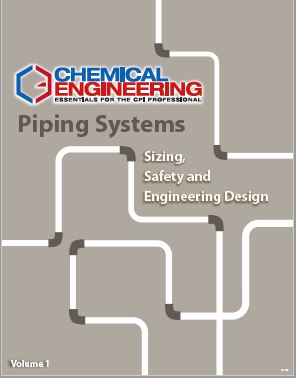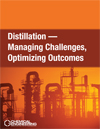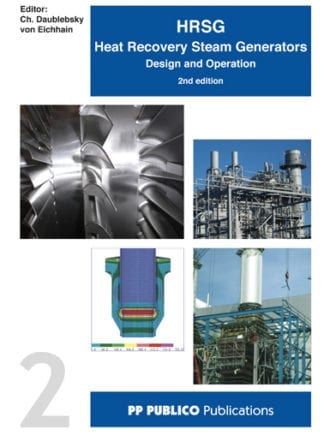Description
Volume 1 of this 2-part guidebook contains practical, how-to engineering articles that were originally published in Chemical Engineering, and useful engineering tip sheets.
The collection of articles provides detailed engineering discussions and recommendations related to the basics of piping design, component selection and proper sizing. Several articles share best practices related to proper operation and maintenance of piping components and systems, and tips for cost estimation related to piping systems.
Find emphasis on safety-related aspects of piping design, minimizing hazards related to leakage, corrosion, vibration and more, as well as the challenges associated with piping systems needed to safeguard the integrity of high-purity chemicals and products and hazardous substances.
This guidebook is available in PDF format of 227 pages.
Articles Include:
Characterize Bulk Solids to Ensure Smooth Flow
• To minimize problems associated with handling all types of bulk solids, engineers must adopt a systematic approach to characterizing the flow and mechanical properties of the materials under a variety of operating conditions
Designing Safer Process Plants
• Several often-overlooked strategies to increase inherent safety are discussed here
Principles of P&ID Development
• The tips provided here will streamline efforts to develop piping & instrumentation diagrams
Hot-oil heat-tracing systems Particle Impact Problems in Pneumatic Conveying
• Pneumatically conveyed solid materials inevitably impact pipewalls and other particles, which can create processing and equipment problems. Provided here is an outline of potential problems related to particle impacts and the physics behind them
Pipe Sizing
Pipe Bends in Dilute-phase Pneumatic Conveying
High Purity Chemicals: Processing Equipment Essentials
• Some practical tips regarding the design and fabrication of piping systems and equipment for high-purity applications are presented here
Improve Your Contingency Estimates for More Realistic Project Budgets
• Reliable risk-analysis and contingency-estimation practices help to better manage costs in CPI projects of all sizes
Common Mistakes When Conducting a HAZOP and How to Avoid Them
• An important part of ensuring the success of a HAZOP study is to understand the errors that can cause the team to lose focus
Process Plant Layout — Becoming a Lost Art?
• Plant layout is as important a part of process plant design as it ever was, but it is rarely taught as part of chemical engineering courses
Inspecting Underground Piping
• First consider noninvasive methods to determine where excavation is — and isn’t — necessary
Flow Measurement in Large Lines, Ducts and Stacks
Active Management of Pipespool Fabricators
• Contractors need to integrate and engage to improve deliveries and shorten project schedules
Updating the Rules For Pipe Sizing
• The most economical velocity in piping has shifted downward over the last 40 years
Pressurized Piping: Sampling Steam and Water
• Without proper systems, analysis of steam and water chemistry can provide erroneous results — with costly implications
Plot Plan Design: Process Requirements
• It is important to conceptualize plant layout in terms of both ideal location and optimal geographical positioning of equipment components
Process Hazards Analysis Methods
New Piping Code for High-Purity Processes
• It is essential that industry codes, standards and regulations keep up with evolving technology and changing demands of the chemical process industries
Rupture Discs: Effectively Minimize Leaks and Emissions
• When installing rupture discs, there are several mechanical and operational considerations for reducing the likelihood of leaks and fugitive emissions
Piping Design for Hazardous Fluid Service
• Extra considerations and precautions are needed beyond the requirements of codes and standards
Reduce Gas Entrainment In Liquid Lines
• Follow these tips to properly size self-venting lines and vortex breakers
Combining the use of Rupture Discs with Relief Valves
• Using the two devices together offers significant benefits in chemical processes. Here is how to take advantage of them
Modern Rupture Discs Support Increased Plant Capacity
• The use of today’s high-performance rupture disc designs can help to reduce many common operating problems and support increased throughput requirements
Field Troubleshooting 101 and How to Get the Job Done
• A major part of field work lies in troubleshooting problems: finding out why a system is not operating the way it is intended. This article provides guidelines for effective
troubleshooting and contains many practical examples of their successful use
Short-Cut Piping Costs
• This method saves precious time in preparing estimates for pre-design and other approximated analyses
A Method for Quantifying Pipe Vibrations
• A technique to quantify vibration forces can help prevent pipe failures due to vibration-induced fatigue
Piping-System Leak Detection and Monitoring for the CPI
• Eliminating the potential for leaks is an integral part of the design process that takes place at the very onset of facility design
Insulating Heat-Transfer-Fluid Piping
Integrated Risk-Management Matrices
• An overview of the tools available to reliability professionals for making their organization the best-in-class
De-emphasize Capital Costs For Pipe Size Selection
• Focus more on mass flowrates, fluid densities and operating hours for real savings
Piping Design for Potentially Lethal Chemicals
• Integrity and reliability are critical for piping and equipment that handle chemicals with extreme health hazards
Critical Connections Demand Certainty
• Understanding bolts’ behavior during routine tightening procedures helps to ensure leak-free, reliable operations
Considering Fugitive Emissions During the Conceptual Design Stage
• The ability to reduce fugitive emissions through the use of strategic design modifications not only protects workers and the environment, but reduces losses of valuable process materials
Forces Acting on a Gasket
Pneumatic Conveying: Optimal System Design,Operation and Control
• Numerous strategies and options for both dilute- and densephase conveying systems are presented here
Pipe Insulation: Finding the Optimal Thickness
• Avoid tedious numerical calculation by using this quick, shortcut method
Piping Codes: What the CPI Engineer Should Know
• An overview of the codes and standards that are most pertinent to chemical processing facilities
An Overview of Vacuum System Design
• The design of vacuum systems deserves careful attention — there are multiple facets that affect efficiency, operability and cost
Spill Containment: An Often-Overlooked Hazard in Research
• With proper planning, spills can be managed properly and the risk of secondary events — which may be more dangerous and costly — can be reduced




